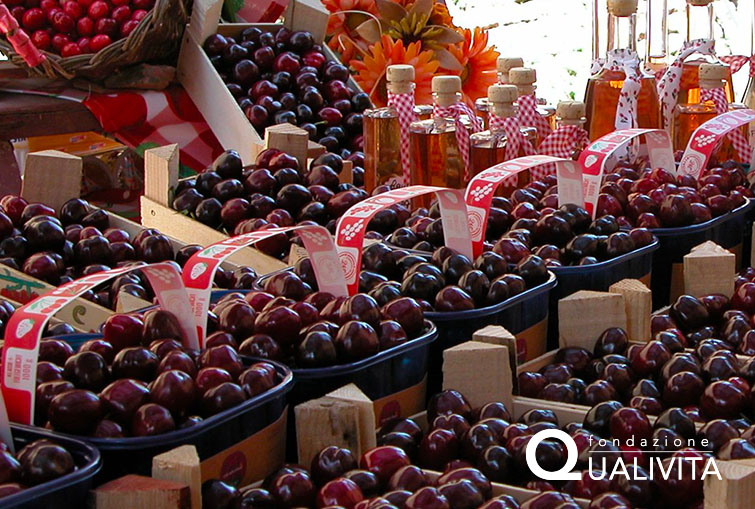Fruit size is a key characteristic for both commercial acceptance and postharvest efficiency.
Although the average diameter of commercial cultivars typically ranges between 20 and 30 mm, the latest varieties developed through breeding programs usually exceed 30 mm, reflecting a significant advancement in the selection of larger-caliber genotypes.
The development of fruit size is a complex physiological process, regulated by a program known as double sigmoid growth: a pattern that defines a precise sequence of molecular, hormonal, and structural changes.
This sequence shapes the fruit’s anatomy, which, in the case of the cherry, corresponds to that of a drupe.
This type of fruit is composed of three distinct layers: an outer skin or epicarp; a fleshy pulp, the mesocarp; and a hard inner endocarp that encloses the seed.
The biological goal of this developmental program is the optimization of the mesocarp, as its size and composition determine the fruit’s final quality.
Phase I: Cell proliferation
This phase begins immediately after pollination and fertilization of the flower, lasting about 10–25 days.
During this period, the small fruit, still green due to photosynthetic activity, engages in a single decisive physiological process: cell proliferation by mitosis.
The goal of this phase is not to visibly increase size, but to build the fruit’s cellular “framework.”
The final number of cells generated in the mesocarp (the flesh) directly reflects, almost mathematically, the maximum size the cherry can reach.
The two physiological drivers fueling this process are:
Precise hormonal regulation – The process is driven by a hormonal cocktail in which auxins (IAA) and gibberellins (GAs) continuously stimulate cell division (activating cyclins and CDKs), while the inhibitory hormone, abscisic acid (ABA), remains suppressed.
Creation of vascular infrastructure – In parallel, xylem and phloem development (xylogenesis and phloemogenesis) build the vascular network necessary to support growth.
The capacity of this network, defined entirely during this phase, will limit subsequent development.
The principle of cell number
The principle that the number of cells determines potential fruit size has been precisely measured.
There is a direct correlation between the number of mesocarp cell layers and the final fruit diameter.
The study by Olmstead et al. (2007) provides empirical proof: the size difference between the small wild cherry ‘NY 54’ (~28 cell layers) and the large ‘Selah’ (>75 layers) is not random, but a direct consequence of the programmed mitotic activity in their genomes for this phase.
This cell number is not a variable dependent on agronomic management, but a highly heritable genetic trait.
It is the intrinsic potential of each variety, a key target of breeding programs aiming to produce larger cherries.
Phase I, therefore, not only initiates growth: it sets the genetic limits of final fruit size.
Phase II: Pit hardening
After proliferation, the fruit enters a phase of apparent dormancy lasting 10–20 days.
External growth almost completely stops and the color changes from green to light yellow.
However, this halt in growth is only apparent: internally, energy is concentrated on crucial processes.
Hormonally, ABA levels, though still low, start to rise, preparing the fruit for final ripening.
The two key events of this phase are:
The chemistry of hardening – The central process is endocarp lignification.
The cells of this layer synthesize and deposit lignin—a complex phenolic polymer—into their cell walls.
Catalyzed by enzymes such as peroxidases and laccases, this results in the formation of an extremely hard and resistant pit, which protects the embryo.
Crisis and transition in vascular transport – The increasing rigidity of the pit exerts physical pressure on the vascular system, causing cavitation (rupture) of many xylem vessels and interrupting water flow through this pathway.
As a result, the fruit is forced into a physiological transition, becoming increasingly dependent on the phloem for water and sugar import.
Phase III: Final expansion
This is the final and most spectacular stage of development, lasting 15–25 days until harvest.
The fruit undergoes a second rapid phase of exponential growth, no longer creating new cells, but expanding those already present.
Fueled by massive accumulation of water and sugars in the vacuoles, the cells swell dramatically.
In this phase, all key attributes that make the cherry ready for harvest are defined.
Development of flavor and color – Biochemically, the fruit transforms.
Large amounts of anthocyanins accumulate in the skin, the pigments responsible for the characteristic deep red or mahogany color.
At the same time, flavor evolves toward its optimal point: soluble sugars (mainly D-glucose) increase, while organic acid concentration decreases, creating the perfect sweet-acid balance.
Texture modification: controlled softening – Texture also changes with a progressive loss of firmness.
This softening is a controlled process of cell wall disassembly, orchestrated by ABA, which peaks here.
ABA activates the expression of genes encoding key hydrolytic enzymes:
Polygalacturonase (PG) and Pectin methylesterase (PME) – These degrade pectins, the “cement” holding cells together.
Expansins – These loosen the cellulose-hemicellulose network, increasing wall viscoelasticity and allowing the flesh to become soft and juicy.
The associated risk: the physics of cracking – This rapid expansion is not without risk.
Sugar accumulation in the vacuole creates a very negative osmotic potential that attracts water by osmosis, generating high turgor pressure.
Cracking occurs when this internal pressure exceeds the elastic limit of the epidermis: the skin, under extreme tension, can no longer stretch and tears, compromising fruit quality and integrity.
Genetics vs physiology
The cherry’s journey through these three phases reveals a fundamental lesson about the biology of size.
The final size we observe and value is not the result of a single process, but of an essential duality:
Phase I sets the genetic potential of size: through cell proliferation a maximum number of cells is established, serving as the fruit’s architectural blueprint.
This number is an intrinsic trait of each variety, defined by its DNA.
Phase III, instead, physiologically fulfills that potential: through cell expansion, and under the influence of factors such as irrigation and nutrition, the fruit “fills” the potential set in the first phase.
Phase II serves as the indispensable bridge between creating the potential and realizing it.
The conclusion is clear: the true secret to large size is not in “inflating” cells in the final phase, but in the genetic capacity to create a greater number of them from the very beginning.
And this raises a question that will set the stage for the next analysis: if the number of cells is the decisive genetic factor, which specific genes act as conductors in Phase I?
Which DNA sequences instruct a cherry to produce twice as many cells as another?
The answer will take us into the fascinating world of genomics and precision breeding, a journey into the heart of the cherry’s DNA that we will explore in the next analysis.
Image source: SL Fruit Service
Jesus Alonso
Elmundocereza
Cherry Times - All rights reserved












